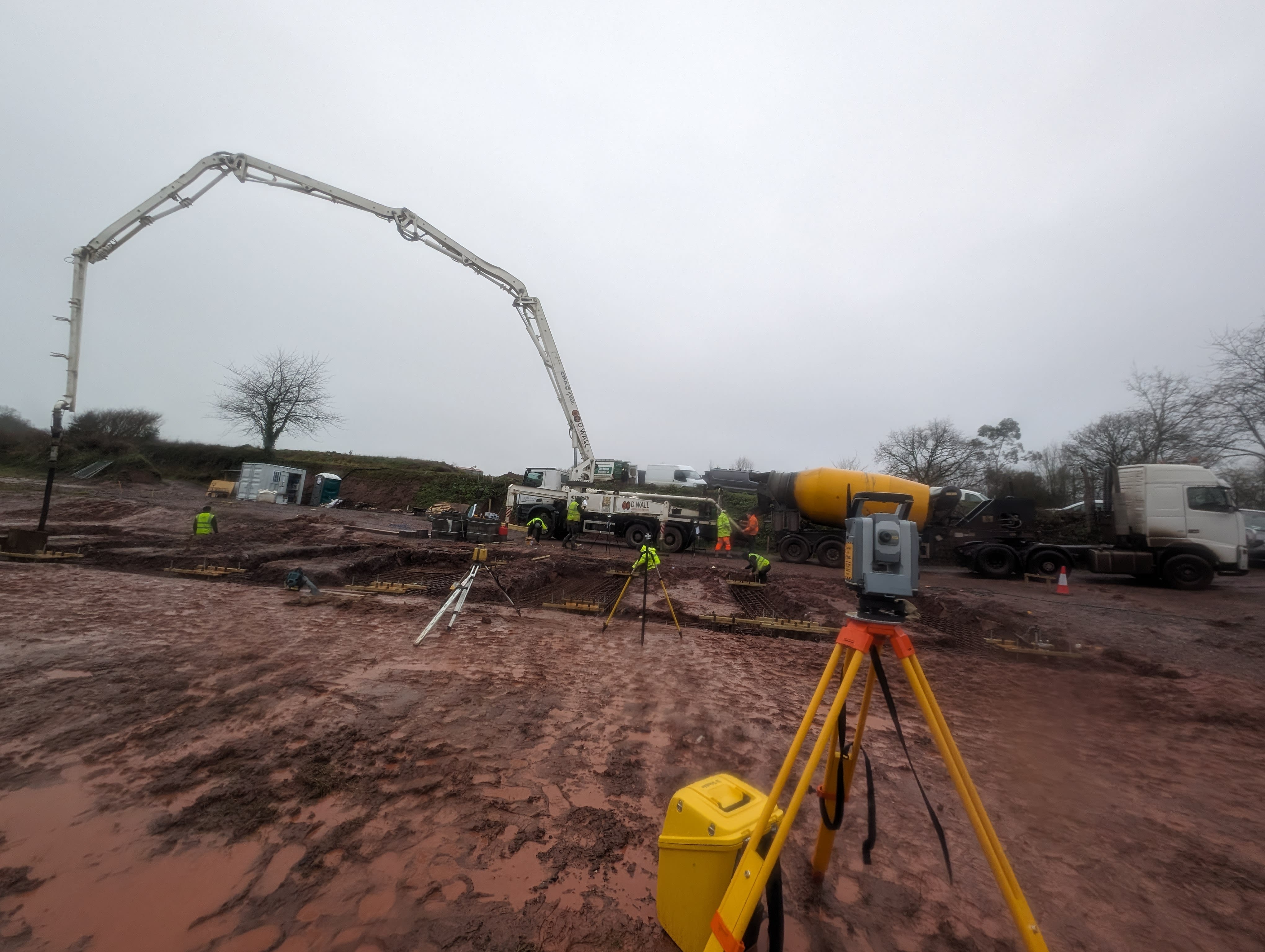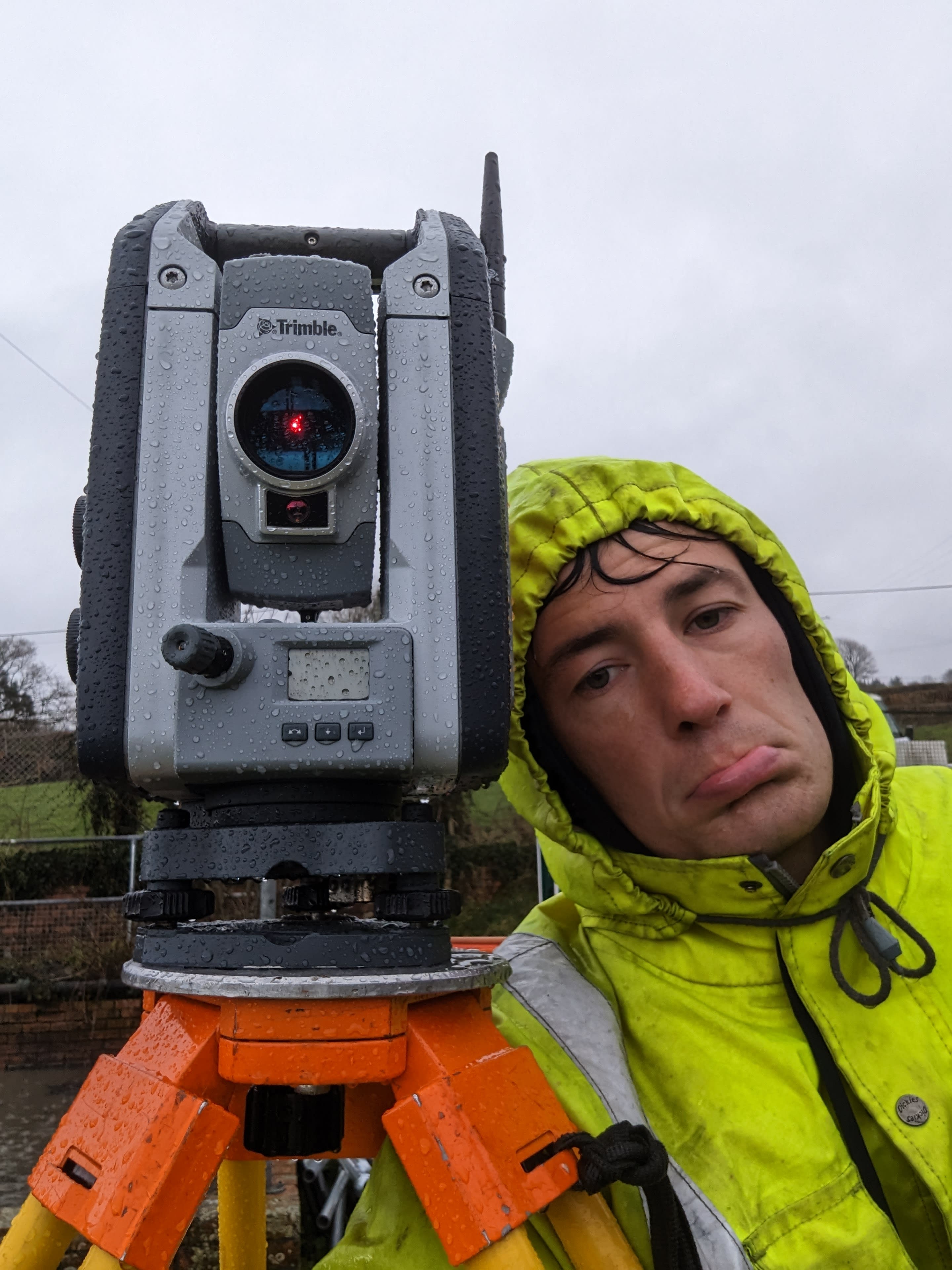What Does a Total Station IP Rating Mean?
Spinning under a shower of water, this Trimble® S9 total station demonstration is more than a splashy talking point at conferences. It’s a demonstration of what an IP rating means and why businesses can rely on total stations to work in almost any weather and condition — for hours, days, or even years at a time.

IP = Ingress Protection
Ingress Protection (IP) ratings were developed by the International Electrotechnical Organization as a unified industry standard in 1976. As electronics will deteriorate or malfunction if water or dust enters the device, the IP rating shows the level of protection provided by the device’s enclosure against the intrusion of dust or liquids.

Courtesy of James Richard, Benchmark Surveys
All Trimble robotic total stations have an IP65 rating. The first digit (IP65) is the solid particle protection. Refer to the table below:
Solid particle protection
|
Level |
Effective Against |
Description |
|
X |
Unknown |
No data is available to specify a protection rating about this criterion |
|
0 |
N/A |
No protection against contact and ingress of objects |
|
1 |
> 50 mm 2.0 in |
Any large surface of the body, such as the back of a hand, but no protection against deliberate contact with a body part |
|
2 |
> 12.5 mm 0.49 in |
Fingers or similar objects |
|
3 |
> 2.5 mm 0.098 in |
Tools, thick wires, etc. |
|
4 |
> 1 mm 0.039 in |
Most wires, slender screws, large ants, etc. |
|
5 |
Dust protected |
Ingress of dust is not entirely prevented, but it must not enter in sufficient quantity to interfere with the safe operation of the equipment |
|
6 |
Dust-tight |
No ingress of dust; complete protection against contact (dust-tight). A vacuum must be applied. Test duration of up to 8 hours based on airflow. |
In this case, the solid particle protection rating is the highest a product can achieve: 6. It is dust-tight, allowing complete protection against particle ingress.
The second digit (IP65), refers to the level of water ingress. The table below shows how much at each level is allowed:
Protection against water ingress
|
Level |
Protection Against |
Effective Against |
Description |
|
X |
Unknown |
N/A |
No data is available to specify a protection rating concerning these criteria |
|
0 |
None |
N/A |
No protection against ingress of water |
|
1 |
Dripping Water |
Dripping water (vertically falling drops) shall have no unsafe effect on the specimen when mounted upright onto a turntable and rotated at 1 RPM. |
Test duration: 10 minutes Water equivalent to 1 mm (0.039 in) rainfall per minute |
|
2 |
Dripping water when tilted at 15° |
Vertically dripping water shall have no harmful effect when the enclosure is tilted at an angle of 15° from its normal position. A total of four positions are tested within two axes. |
Test duration: 2.5 minutes for every direction of tilt (10 minutes total) Water equivalent to 3 mm (0.12 in) rainfall per minute |
|
3 |
Spraying water |
Water falling as a spray at any angle up to 60° from the vertical shall have no harmful effect, utilizing either: a) an oscillating fixture, or b) A spray nozzle with a counterbalanced shield. Test a) is conducted for 5 minutes, then repeated with the specimen rotated horizontally by 90° for the second 5-minute test. Test b) is conducted (with a shield in place) for 5 minutes minimum. |
For a spray nozzle: Test duration: 1 minute per square meter for at least 5 minutes, water volume: 10 liters per minute (0.037 impgal/s) Pressure: 50–150 kPa (7.3–21.8 psi) For an oscillating tube: Test duration: 10 minutes, water volume: 0.07 liters per minute (0.00026 impgal/s) per hole |
|
4 |
Splashing of water |
Water splashing against the enclosure from any direction shall have no harmful effect, utilizing either: a) an oscillating fixture, or b) A spray nozzle with no shield. Test a) is conducted for 10 minutes. b) is conducted (without shield) for 5 minutes minimum. |
Oscillating tube: Test duration: 10 minutes, or spray nozzle (same as IPX3 spray nozzle with the shield removed) |
|
5 |
Water jets |
Water projected by a nozzle (6.3 mm (0.25 in)) against enclosure from any direction shall have no harmful effects. |
Test duration: 1 minute per square meter for at least 3 minutes Water volume: 12.5 liters per minute Pressure: 30 kPa (4.4 psi) at distance of 3 meters (9.8 ft) |
|
6 |
Powerful water jets |
Water projected in powerful jets (12.5 mm (0.49 in)) against the enclosure from any direction shall have no harmful effects. |
Test duration: 1 minute per square meter for at least 3 minutes Water volume: 100 liters per minute (0.37 impgal/s) Pressure: 100 kPa (15 psi) at distance of 3 meters (9.8 ft) |
|
6k |
Powerful water jets with increased pressure |
Water projected in powerful jets (6.3 mm (0.25 in) nozzle) against the enclosure from any direction, under elevated pressure, shall have no harmful effects. Found in DIN 40050, and not IEC 60529. |
Test duration: at least 3 minutes Water volume: 75 liters per minute (0.27 impgal/s) Pressure: 1,000 kPa (150 psi) at distance of 3 meters (9.8 ft) |
|
7 |
Immersion, up to 1 meter (3 ft 3 in) depth |
Ingress of water in harmful quantity shall not be possible when the enclosure is immersed in water under defined conditions of pressure and time (up to 1 meter (3 ft 3 in) of submersion). |
Test duration: 30 minutes Tested with the lowest point of the enclosure 1,000 mm (39 in) below the surface of the water, or the highest point 150 mm (5.9 in) below the surface, whichever is deeper. |
|
8 |
Immersion, 1 meter (3 ft 3 in) or more depth |
The equipment is suitable for continuous immersion in water under conditions which the manufacturer shall specify. However, with certain types of equipment, it can mean that water can enter but only so that it produces no harmful effects. The test depth and duration are expected to be greater than the requirements for IPx7, and other environmental effects may be added, such as temperature cycling before immersion. |
Test duration: agreement with the manufacturer Depth specified by the manufacturer, generally up to 3 meters (9.8 ft) |
|
9 |
Powerful high-temperature water jets |
Protected against close-range high-pressure, high-temperature spray downs. Smaller specimens rotate slowly on a turntable from 4 specific angles. Larger specimens are mounted in the intended position when used, no turntable required, and are tested freehand for at least 3 minutes at a distance of 0.15–0.2 meters (5.9 in – 7.9 in). The specific requirements for the test nozzle are shown in figures 7, 8, & 9 of IEC (or EN) 60529. This test is identified as IPx9 in IEC 60529. |
Test duration: Fixture: 30 sec. in each of 4 angles (2 min. total), Freehand: 1 min/m2, 3 min. minimum Water volume: 14–16 liters per minute (0.051–0.059 impgal/s) Pressure: 8–10 MPa (80–100 bar) at distance of 0.10–0.15 meters (3.9 in – 5.9 in) Water temperature: 80 °C (176 °F) |
The “5” rating for IP65-rated Trimble robotic total stations means they are protected from water directed at the instrument from a nozzle from any direction. Outside of the confines of a lab or the controlled circumstances at an indoor trade show, that rating means much more.

Courtesy of Control Point Associates
The real-world results of an IP65 rating
It means whether you’re working on a dust-blown construction site, deep underground in a mine, or in a sandy desert, you can be confident that your instrument won’t be full of dust and grit at the end of a hard day’s work.
If you’re setting up for a monitoring campaign, you can rest assured that no matter the conditions your total station will face during its life as a monitoring instrument, it will keep working day and night to ensure safety on the job.
 Courtesy of James Richard, Benchmark Surveys
Courtesy of James Richard, Benchmark Surveys
“The S series products are so dependable. I never question whether they're going to work when I get them out of the box. They're super reliable; they just work!”
— Andrew Gorge, Owner, Cornish Engineering Surveys Ltd., United Kingdom
The IP65 rating also means that the instrument will work with no ill effects through even the wettest days, without an aftermarket rain jacket or rain protection. (If you are working in wet weather, Trimble recommends giving the instrument a good dry with a towel when putting away for the day, and getting it out of the box to dry properly overnight to prevent condensation building up inside the total station housing.)

Courtesy of James Richard, Benchmark Surveys
IP65 ratings mean that, even after a lifetime of hard, rainy or stormy weather days when a jacket and hood is necessary for yourself, total stations will keep working uninterrupted perfectly for years.